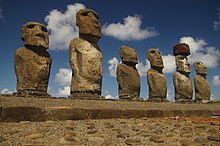Solar eclipse of July 11, 2010
| Solar eclipse of July 11, 2010 | |
|---|---|

|
|
| classification | |
| Type | Total |
| area |
Pacific , South South America Total: South Pacific , Easter Island , Chile , Argentina |
| Saros cycle | 146 (27 of 76) |
| Gamma value | −0.6789 |
| Greatest eclipse | |
| Duration | 5 minutes 20 seconds |
| place | South pacific |
| location | 19 ° 46 ′ S , 121 ° 53 ′ W |
| time | July 11, 2010 7:33:34 PM UT |
| size | 1.0580 |
The total solar eclipse of July 11, 2010 took place almost exclusively over the southern Pacific . With a maximum total duration of 5 minutes and 20 seconds, this solar eclipse is one of the longer.
The atolls Hikueru and Amanu , which belong to Polynesia, were in the total zone, and Easter Island was also on the path of the umbra . There the total was 4 minutes and 50 seconds, with the umbra that was 186 kilometers wide covering the entire island.
The partial phases were also not observable from Europe.
course
3000 kilometers northeast of New Zealand , near the Tonga Islands ( 26 ° 52 ′ S , 170 ° 59 ′ W ), the umbra of the moon hit the earth for the first time. There the eclipse took place during the sunrise. The umbra then crossed the entire Pacific. Towards the end, the eclipse in Chile reached the South American continent, crossed Patagonia and ended in the southern Argentine Andes . With the totality lasting around 2 minutes, the setting sun was only 2 ° above the horizon.
The climax of the eclipse was at 19:34 UT ( Universal Time ) in the middle of the Pacific ( 19 ° 46 ′ S , 121 ° 53 ′ W ), 2000 kilometers east of the Tuamotu Islands . On the central line the maximum duration of 5 minutes and 20 seconds totality was reached, the umbra was 259 kilometers wide, the eclipsed sun was 47 ° above the northern horizon.
In its partial phase, the eclipse could be observed from large parts of the South Pacific, Polynesia , the Cook Islands and the southern areas of South America.
The following eclipses
The next central solar eclipse will take place more than 22 months after this, on May 20, 2012 . In contrast to this, this eclipse is ring-shaped and can be seen in East Asia and North America . In 2011 there is no central solar eclipse at all, but four partial eclipses occur: on January 4th , June 1st , July 1st and November 25th . The eclipse of January 4th 2011 could be observed in Central Europe in good weather conditions in the morning hours.
literature
- Hans-Ulrich Keller (Ed.): Kosmos Himmelsjahr 2010 . Franckh-Kosmos, Stuttgart 2009, ISBN 978-3-440-11532-9 .
- Wolfgang Held: Solar and lunar eclipses . Free Spiritual Life Publishing House, Stuttgart 2005, ISBN 3-7725-2231-9
